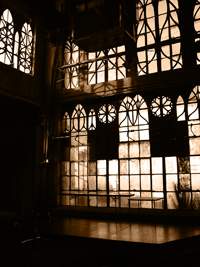 Exciting news for the Bay Area theatre community: Z Space, one of the area’s most innovative developers and presenters of new plays, is moving to the 286-seat Theatre Artaud, a venerable old performance building in the Mission/Potrero Hill neighborhood of San Francisco. The signing of the 10-year lease on the building represents the first time that Z Space has had its own space.
Exciting news for the Bay Area theatre community: Z Space, one of the area’s most innovative developers and presenters of new plays, is moving to the 286-seat Theatre Artaud, a venerable old performance building in the Mission/Potrero Hill neighborhood of San Francisco. The signing of the 10-year lease on the building represents the first time that Z Space has had its own space.
Theatre Artaud hasn’t been a permanent home for a company in quite a few years. Built as an American Can Company tooling factory in 1925, the shop provided jobs for San Francisco Mission District families through the 1960s. In 1971, a group of artists moved into the abandoned industrial building, naming it Project Artaud, for French avant-garde theater artist, Antonin Artaud (1896-1948), who believed art should happen in non-traditional spaces. Today, there are more than 70 individual artists’ live/work studios at Project Artaud, in addition to arts related nonprofits, small artist businesses, studio theaters and galleries.
With this move to a new base, Z Space plans to expand its offerings to San Francisco performing artists and audiences, and curate a multidisciplinary presenting program featuring theatre, dance, visual, and multimedia arts.
Z Space Executive Artistic Director Lisa Steindler will continue to oversee all of the organization’s operations, and will also continue to develop and produce new work. Z Space Managing Director David Szlasa will take on a more active programming role, and will work closely with the artistic community to solicit proposals and curate the space.
On a personal note, I’m thrilled about the news. Theatre Artaud is one of my favorite places to see work. It has a spacious, airy feel to it, and is the sort of space that can easily be transformed to fit the needs of a wide variety of artworks including dance, concerts, straight plays, art exhibitions and multimedia work. Artaus is also very easily accessible public transport-wise and is within striking distance of a bunch of great restaurants, bars and cafes. I can’t think of a better home for Z Space and I wish the company well as it embarks upon this new chapter of its life.













